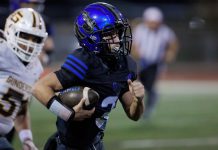As loud as 70,000-plus screaming football fans can be, it’s the
sound of silence that can be deafening. The roar of a home crowd is
a cadence usually only interrupted when something goes wrong.
Editor’s Note:
This is the second article in a three-part series about head and neck injuries in football and how prepared local sports programs are in preventing and responding to such injuries.
As loud as 70,000-plus screaming football fans can be, it’s the sound of silence that can be deafening. The roar of a home crowd is a cadence usually only interrupted when something goes wrong.
On Sept. 9, Ralph Wilson Stadium had 73,967 people watching the Buffalo Bills play host to the Denver Broncos in the opening Sunday of this year’s NFL season.
At the beginning of the third quarter, the game became a secondary concern as Bills’ tight end Kevin Everett lay still on the turf. His head had just collided with the shoulder pad of Denver’s kick returner Domenik Hixon, breaking the third and fourth vertebrae in his spine. Everett was knocked unconscious and had no feeling in his limbs after waking. He was rushed to the hospital by ambulance and doctors implemented a rarely used and risky procedure of pumping an ice-cold saline solution into his system by catheter to induce hypothermia. The goal was to limit swelling in the cervical cord and brain, while slowing down his metabolic rate.
In surgery just hours after the injury, the initial prognosis was Everett would never walk again, and may not survive.
Two months after his injury though, he has regained enough strength and coordination to hold himself up on a walker and use his feet to push himself around in a wheelchair. The saline solution is being credited with saving his life and giving him the possibility of walking in the future.
“The central nervous system has a very high metabolic rate and if you slow metabolism by bringing down the temperature in any system … [the injured person is] less vulnerable to injury,” said Dr. Emeka Nchekwube, a Morgan Hill-based neurosurgeon. “It buys you some time and minimizes damage to vital organs because it slows down the metabolic rate. You don’t want to overdo it. When body temperature goes down too low it can do damage to the heart … We [started doing] this with the brain many years ago. With the spinal cord it is relatively new.”
Gilroy’s Head Athletic Trainer Jennfier Spinetti said Everett was lucky to have such a quick response.
“They handled it very well and obviously at the NFL you have more highly trained medical professionals,” she said.
But when a player is unconscious and not breathing, the focus is squarely on saving the player’s life.
“On top of his neck injury, their primary goal was to make sure his airway (was clear) – breathing and circulation – keep him alive,” Spinetti said. “Paralysis is secondary.”
Many who have seen the injury point to poor tackling form as the cause. Lowering his head, rather than delivering a blow with a shoulder, Everett suffered his injury from axial loading, which occurs when force is sent down the length of the spine through a partially flexed neck, according to the National Spinal Cord Injury Association. The NSCIA says axial loading is “the mechanism most likely to lead to permanent quadriplegia in injured athletes.”
Quadraplegia, also called tetraplegia, is when a person experiences paralysis in all four limbs but not necessarily a complete loss of ability.
Nchekwube said it’s critical that coaches teach their players proper form-tackling while also training neck muscles in the preseason for high-impact collisions.
“Injury prevention is a very important part of the equation,” Nchekwube said. “People need to maintain good spine hygeine, working out to build up the muscles of the exo-skeleton. Most linebackers are pretty good at this. If you look at a linebacker, they don’t have a neck. There is good reason for that.”
David A. Tari, who is in his 11th year as a Certified Athletic Trainer for San Benito High School, said it’s also important for referees to enforce the rules against leading with one’s head when tackling.
“With high school kids, they see what the pros are doing — trickle down effect,” Tari said. “[Referees] need to be more diligent with that, especially if there is a definite safety violation.
But Tari added that proper tackling technique should be taught. Said Tari, “Keep your head up. Hit what you see, see what you hit.”
The NSCIA estimates 450,000 people in the United States are currently living with a spinal cord injury. Since 2000, 8.7 percent of spinal cord injuries have occurred while playing sports related activities.
Charity Deguzman, the athletic trainer at Ann Sobrato High School, said spinal cord injuries should always be treated seriously.
“I did have to treat a sublex-disk spinal injury a couple years ago for a player on the Monta Vista football team,” Deguzman said. “He said he was feeling tingling in his spine, and we were not sure if it was a cervical injury, so to be cautious, he had to be taken off on a stretcher.
“Spinal injuries are tricky because you don’t automatically know what it is.”
While Everett was saved through the use of an ice-cold saline solution, Nchekwube said the likelihood of needing such a tool to treat spinal cord injuries is too rare for all football programs to keep one on hand.
“You’re looking at a very small subset of injured people who might benefit from this,” he said.
More importantly, Nchekwube said, is to have “a designated hospital, where people are skilled at these particular types of injuries. Have an ambulance and first-responder team at the scene of the sport so that the injured athlete can be rapidly moved.”
Spinetti said that Gilroy High can’t always have an ambulance on call, but the school is well-prepared.
“We’re fortunate here because we have three medical professionals that volunteer their time at our games,” she said.
Andrew Matheson and Paul Doherty contributed to this report.













